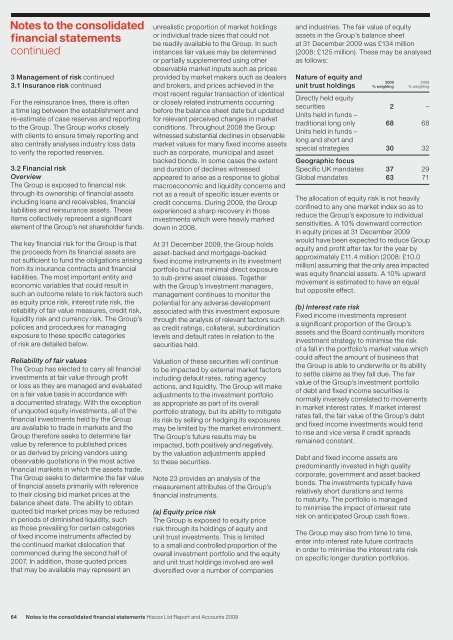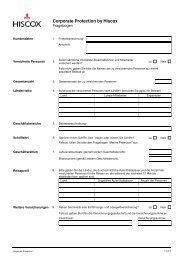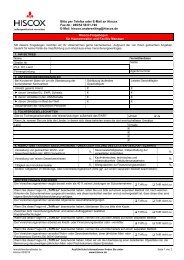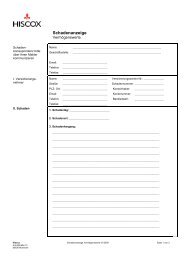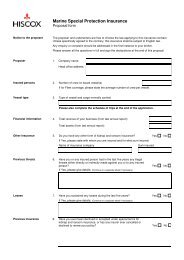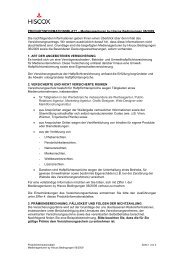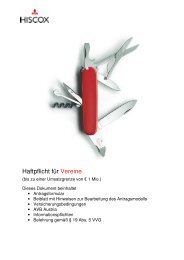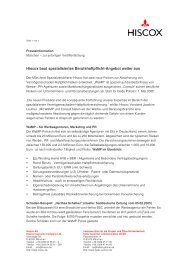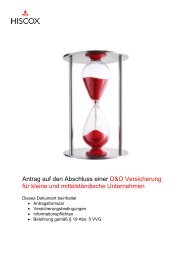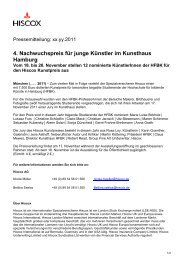Download PDF - Hiscox
Download PDF - Hiscox
Download PDF - Hiscox
Create successful ePaper yourself
Turn your PDF publications into a flip-book with our unique Google optimized e-Paper software.
Notes to the consolidated<br />
financial statements<br />
continued<br />
3 Management of risk continued<br />
3.1 Insurance risk continued<br />
For the reinsurance lines, there is often<br />
a time lag between the establishment and<br />
re-estimate of case reserves and reporting<br />
to the Group. The Group works closely<br />
with clients to ensure timely reporting and<br />
also centrally analyses industry loss data<br />
to verify the reported reserves.<br />
3.2 Financial risk<br />
Overview<br />
The Group is exposed to financial risk<br />
through its ownership of financial assets<br />
including loans and receivables, financial<br />
liabilities and reinsurance assets. These<br />
items collectively represent a significant<br />
element of the Group’s net shareholder funds.<br />
The key financial risk for the Group is that<br />
the proceeds from its financial assets are<br />
not sufficient to fund the obligations arising<br />
from its insurance contracts and financial<br />
liabilities. The most important entity and<br />
economic variables that could result in<br />
such an outcome relate to risk factors such<br />
as equity price risk, interest rate risk, the<br />
reliability of fair value measures, credit risk,<br />
liquidity risk and currency risk. The Group’s<br />
policies and procedures for managing<br />
exposure to these specific categories<br />
of risk are detailed below.<br />
Reliability of fair values<br />
The Group has elected to carry all financial<br />
investments at fair value through profit<br />
or loss as they are managed and evaluated<br />
on a fair value basis in accordance with<br />
a documented strategy. With the exception<br />
of unquoted equity investments, all of the<br />
financial investments held by the Group<br />
are available to trade in markets and the<br />
Group therefore seeks to determine fair<br />
value by reference to published prices<br />
or as derived by pricing vendors using<br />
observable quotations in the most active<br />
financial markets in which the assets trade.<br />
The Group seeks to determine the fair value<br />
of financial assets primarily with reference<br />
to their closing bid market prices at the<br />
balance sheet date. The ability to obtain<br />
quoted bid market prices may be reduced<br />
in periods of diminished liquidity, such<br />
as those prevailing for certain categories<br />
of fixed income instruments affected by<br />
the continued market dislocation that<br />
commenced during the second half of<br />
2007. In addition, those quoted prices<br />
that may be available may represent an<br />
unrealistic proportion of market holdings<br />
or individual trade sizes that could not<br />
be readily available to the Group. In such<br />
instances fair values may be determined<br />
or partially supplemented using other<br />
observable market inputs such as prices<br />
provided by market makers such as dealers<br />
and brokers, and prices achieved in the<br />
most recent regular transaction of identical<br />
or closely related instruments occurring<br />
before the balance sheet date but updated<br />
for relevant perceived changes in market<br />
conditions. Throughout 2008 the Group<br />
witnessed substantial declines in observable<br />
market values for many fixed income assets<br />
such as corporate, municipal and asset<br />
backed bonds. In some cases the extent<br />
and duration of declines witnessed<br />
appeared to arise as a response to global<br />
macroeconomic and liquidity concerns and<br />
not as a result of specific issuer events or<br />
credit concerns. During 2009, the Group<br />
experienced a sharp recovery in those<br />
investments which were heavily marked<br />
down in 2008.<br />
At 31 December 2009, the Group holds<br />
asset-backed and mortgage-backed<br />
fixed income instruments in its investment<br />
portfolio but has minimal direct exposure<br />
to sub-prime asset classes. Together<br />
with the Group’s investment managers,<br />
management continues to monitor the<br />
potential for any adverse development<br />
associated with this investment exposure<br />
through the analysis of relevant factors such<br />
as credit ratings, collateral, subordination<br />
levels and default rates in relation to the<br />
securities held.<br />
Valuation of these securities will continue<br />
to be impacted by external market factors<br />
including default rates, rating agency<br />
actions, and liquidity. The Group will make<br />
adjustments to the investment portfolio<br />
as appropriate as part of its overall<br />
portfolio strategy, but its ability to mitigate<br />
its risk by selling or hedging its exposures<br />
may be limited by the market environment.<br />
The Group’s future results may be<br />
impacted, both positively and negatively,<br />
by the valuation adjustments applied<br />
to these securities.<br />
Note 23 provides an analysis of the<br />
measurement attributes of the Group’s<br />
financial instruments.<br />
(a) Equity price risk<br />
The Group is exposed to equity price<br />
risk through its holdings of equity and<br />
unit trust investments. This is limited<br />
to a small and controlled proportion of the<br />
overall investment portfolio and the equity<br />
and unit trust holdings involved are well<br />
diversified over a number of companies<br />
64 Notes to the consolidated financial statements <strong>Hiscox</strong> Ltd Report and Accounts 2009<br />
and industries. The fair value of equity<br />
assets in the Group’s balance sheet<br />
at 31 December 2009 was £134 million<br />
(2008: £125 million). These may be analysed<br />
as follows:<br />
Nature of equity and<br />
unit trust holdings<br />
2009 2008<br />
% weighting % weighting<br />
Directly held equity<br />
securities<br />
Units held in funds –<br />
2 –<br />
traditional long only<br />
Units held in funds –<br />
long and short and<br />
68 68<br />
special strategies<br />
Geographic focus<br />
30 32<br />
Specific UK mandates 37 29<br />
Global mandates 63 71<br />
The allocation of equity risk is not heavily<br />
confined to any one market index so as to<br />
reduce the Group’s exposure to individual<br />
sensitivities. A 10% downward correction<br />
in equity prices at 31 December 2009<br />
would have been expected to reduce Group<br />
equity and profit after tax for the year by<br />
approximately £11.4 million (2008: £10.0<br />
million) assuming that the only area impacted<br />
was equity financial assets. A 10% upward<br />
movement is estimated to have an equal<br />
but opposite effect.<br />
(b) Interest rate risk<br />
Fixed income investments represent<br />
a significant proportion of the Group’s<br />
assets and the Board continually monitors<br />
investment strategy to minimise the risk<br />
of a fall in the portfolio’s market value which<br />
could affect the amount of business that<br />
the Group is able to underwrite or its ability<br />
to settle claims as they fall due. The fair<br />
value of the Group’s investment portfolio<br />
of debt and fixed income securities is<br />
normally inversely correlated to movements<br />
in market interest rates. If market interest<br />
rates fall, the fair value of the Group’s debt<br />
and fixed income investments would tend<br />
to rise and vice versa if credit spreads<br />
remained constant.<br />
Debt and fixed income assets are<br />
predominantly invested in high quality<br />
corporate, government and asset backed<br />
bonds. The investments typically have<br />
relatively short durations and terms<br />
to maturity. The portfolio is managed<br />
to minimise the impact of interest rate<br />
risk on anticipated Group cash flows.<br />
The Group may also from time to time,<br />
enter into interest rate future contracts<br />
in order to minimise the interest rate risk<br />
on specific longer duration portfolios.


